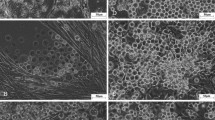Abstract
The DNA content of insect cell lines (6 lepidoptera, 1 coleoptera and 1 diptera) was determined by flow cytometry. The DNA profiles of the 8 cell lines tested were different. They were characterized by the presence of several peaks (2 to 7) corresponding to different ploidy levels, by differences in the fluorescence intensity of each peak and by the proportion of cells in each peak. Two cell lines (Cf124 and BmN) were constituted of 2 distinct populations of cells. The DNA profiles of the cell lines were stable among the passages and during the length of time culture. This technique was demonstrated to be useful for the detection of mixed cell lines and nucleopolyhedrovirus cell infection, using Autographa californica MNPV. The flow cytometry gives interesting results on the cell cycle and the ploidy level; it appears as a good tool for insect cell lines characterization.
Similar content being viewed by others
References
Bello FJ, Brochero H, Boshell J, Olano V and Rey G (1997) Establishment and characterization of a cell line from the mosquito Anopheles albimanus (Diptera: Culicidae). Mem Inst Osawaldo Cruz 92: 123-128.
Belloncik S, Charpentier G and Tian L (1997) Development of four cell lines from the Colorado potato beetle (Leptinotarsa decemlineata). In: Maramorosch K, Mitsuhashi J (eds). Invertebrate cell culture: Novel directions and biotechnology applications. Science Publishers, Inc., Enfield, NH, pp. 3-10.
Charpentier G, Belloncik S, Ducros G, Fontenille D, Tian L and Quiot JM (1995) Establishment and characterization of three cell lines from Aedes triseriatus. J Med Ent 32: 793-800.
Disney JE and McCarthy WJ (1985) A modified technique for the improved characterization of lepidopteran chromosomes from cells in culture. In Vitro Cell Dev Biol 21: 563-568.
Ennis TJ and Sohi SS (1976) Chromosomal characterization of five lepidopteran cell lines of Malacosoma disstria (Lasiocampidae) and Choristoneura fumiferana (Tortricidae). Can J Genet Cytol 18: 471-477.
Eriksson S, Raivio E, Kukkonen JP, Eriksson K and Lindqvist C (1996) Green fluorescent protein as a tool for screening recombinant baculoviruses. J Virol Meth 59: 127-133.
Farmer JL, Hampton RG and Boots E (1989) Flow cytometric assays for monitoring production of recombinant HIV-1 gp160 in insect cells infected with baculovirus expression vector. J Virol Meth 26: 279-290.
Fertig G, Klöppinger M and Miltenburger HG (1990) Cell cycle kinetics of insect cell cultures compared to mammalian cell cultures. Exp Cell Res 189: 208-212.
Greene AE, Charney J, Nichols WW and Coriell LL (1972) Species identity of insect cell lines. In Vitro 7: 313-322.
Hilwig I and Eipel HE (1979a) Characterization of insect cell lines by DNA content. Z Ang Ent 87: 216-220.
Hilwig I and Eipel E (1979b) Determination of virus production in insect cell lines by flow cytometry. Z Ang Ent 88: 225-230.
Hsiao C and Hsiao TH: Inheritance of three autosomal mutations in the Colorado potato beetle Leptinotarsa decemlineata (Coleoptera: Chrysomelidae). Can J Genet Cytol 24: 681-686.
Léry X and Fédière G: Effect of different amino acids and vitamins on lepidopteran cell cultures. J Invertebr Pathol 55: 47-51.
Léry X, Zeddam JL, Giannotti J, Croizier L, Fédière G and Abol-Ela S (1995) Establishment of a cell line derived from embryos of the potato tuber moth Phthorimaea operculella (Zeller). In Vitro Cell Dev Biol 31: 836-839.
Léry X, Giannotti J, Taha A, Ravalec M and Abol-Ela S (1997) Multiplication of a granulosis virus isolated from the potato tuber moth in a new established cell line of Phthorimaea operculella. In Vitro Cell Dev Biol 33: 640-646.
Lynn DE (1995) A new insect cell line from the colorado potato beetle. In Vitro Cell Dev Biol 31: 91-93.
Lynn DE (1996) Development and characterization of insect cell lines. Cytotechnol 20: 3-11.
McIntosh AH, Grasela JJ and Matteri RL (1996) Identification of insect cell lines by DNA amplification fingerprinting (DAF). Insect Mol Biol 5: 187-195.
Oberlander H and Miller S (1987) Lepidoptera cell lines: Tools for research in physiology, development and genetics. In: Maramorosch K (ed), Advances in cell culture: Vol. 5. Academic Press, San Diego, pp. 187-207.
Odier F, Vago P, Quiot JM, Devauchelle G and Bureau JP (1993) Determination of DNA in densovirus-infected invertebrate cell lines by flow cytometry. J Invertebr Pathol 62: 252-256.
Rabinovitch PS and Shankey TV (1994) DNA content and cell cycle analysis in the clinical laboratory. In ISAC XVII Congress, Lake Placid, Oct 16 1994, pp. 1-15.
Traut W and Clarke CA (1997) Karyotype evolution by chromosome fusion in the moth genus Orygia. Hereditas 126: 77-84.
Wolf KW (1994) The unique structutre of lepidopteran spindles. Int Rev Cytol 152: 1-49.
Author information
Authors and Affiliations
Rights and permissions
About this article
Cite this article
Léry, X., Charpentier, G. & Belloncik, S. DNA content analysis of insect cell lines by flow cytometry. Cytotechnology 29, 103–113 (1999). https://doi.org/10.1023/A:1008092620572
Issue Date:
DOI: https://doi.org/10.1023/A:1008092620572




